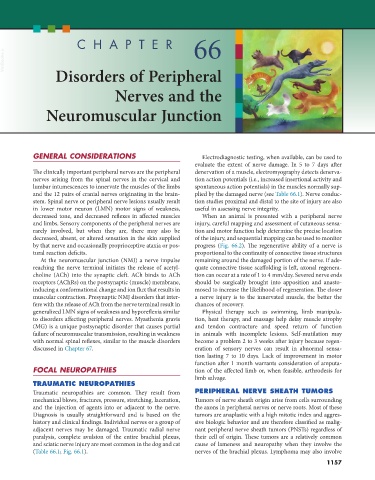Page 1185 - Small Animal Internal Medicine, 6th Edition
P. 1185
CHAPTER 66
VetBooks.ir
Disorders of Peripheral
Nerves and the
Neuromuscular Junction
GENERAL CONSIDERATIONS Electrodiagnostic testing, when available, can be used to
evaluate the extent of nerve damage. In 5 to 7 days after
The clinically important peripheral nerves are the peripheral denervation of a muscle, electromyography detects denerva-
nerves arising from the spinal nerves in the cervical and tion action potentials (i.e., increased insertional activity and
lumbar intumescences to innervate the muscles of the limbs spontaneous action potentials) in the muscles normally sup-
and the 12 pairs of cranial nerves originating in the brain- plied by the damaged nerve (see Table 66.1). Nerve conduc-
stem. Spinal nerve or peripheral nerve lesions usually result tion studies proximal and distal to the site of injury are also
in lower motor neuron (LMN) motor signs of weakness, useful in assessing nerve integrity.
decreased tone, and decreased reflexes in affected muscles When an animal is presented with a peripheral nerve
and limbs. Sensory components of the peripheral nerves are injury, careful mapping and assessment of cutaneous sensa-
rarely involved, but when they are, there may also be tion and motor function help determine the precise location
decreased, absent, or altered sensation in the skin supplied of the injury, and sequential mapping can be used to monitor
by that nerve and occasionally proprioceptive ataxia or pos- progress (Fig. 66.2). The regenerative ability of a nerve is
tural reaction deficits. proportional to the continuity of connective tissue structures
At the neuromuscular junction (NMJ) a nerve impulse remaining around the damaged portion of the nerve. If ade-
reaching the nerve terminal initiates the release of acetyl- quate connective tissue scaffolding is left, axonal regenera-
choline (ACh) into the synaptic cleft. ACh binds to ACh tion can occur at a rate of 1 to 4 mm/day. Severed nerve ends
receptors (AChRs) on the postsynaptic (muscle) membrane, should be surgically brought into apposition and anasto-
inducing a conformational change and ion flux that results in mosed to increase the likelihood of regeneration. The closer
muscular contraction. Presynaptic NMJ disorders that inter- a nerve injury is to the innervated muscle, the better the
fere with the release of ACh from the nerve terminal result in chances of recovery.
generalized LMN signs of weakness and hyporeflexia similar Physical therapy such as swimming, limb manipula-
to disorders affecting peripheral nerves. Myasthenia gravis tion, heat therapy, and massage help delay muscle atrophy
(MG) is a unique postsynaptic disorder that causes partial and tendon contracture and speed return of function
failure of neuromuscular transmission, resulting in weakness in animals with incomplete lesions. Self-mutilation may
with normal spinal reflexes, similar to the muscle disorders become a problem 2 to 3 weeks after injury because regen-
discussed in Chapter 67. eration of sensory nerves can result in abnormal sensa-
tion lasting 7 to 10 days. Lack of improvement in motor
function after 1 month warrants consideration of amputa-
FOCAL NEUROPATHIES tion of the affected limb or, when feasible, arthrodesis for
limb salvage.
TRAUMATIC NEUROPATHIES
Traumatic neuropathies are common. They result from PERIPHERAL NERVE SHEATH TUMORS
mechanical blows, fractures, pressure, stretching, laceration, Tumors of nerve sheath origin arise from cells surrounding
and the injection of agents into or adjacent to the nerve. the axons in peripheral nerves or nerve roots. Most of these
Diagnosis is usually straightforward and is based on the tumors are anaplastic with a high mitotic index and aggres-
history and clinical findings. Individual nerves or a group of sive biologic behavior and are therefore classified as malig-
adjacent nerves may be damaged. Traumatic radial nerve nant peripheral nerve sheath tumors (PNSTs) regardless of
paralysis, complete avulsion of the entire brachial plexus, their cell of origin. These tumors are a relatively common
and sciatic nerve injury are most common in the dog and cat cause of lameness and neuropathy when they involve the
(Table 66.1; Fig. 66.1). nerves of the brachial plexus. Lymphoma may also involve
1157

